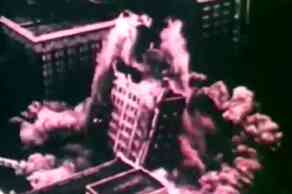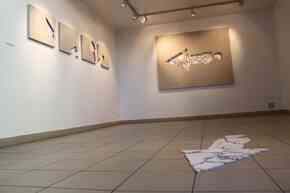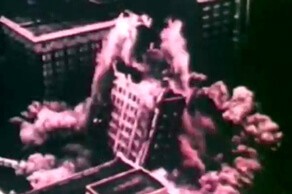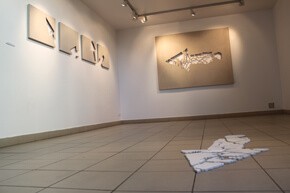Nicolas Ramel
The Associate Artists program has only existed since 2023, but when publishing our archives online (in 2025), we chose to include former Residents of Astérides and Triangle France who, living in Marseille, would today be considered as such.
Nicolas Ramel is an Astérides Resident in 2010 and 2011. The archives of Triangle-Astérides do not allow for the determination of the exact dates or the duration of this residency in 2010 and 2011.
“Works with a Pointed Aim?”
I. Bad Faith
At the origin of many of Nicolas Ramel’s works is the collection of artifacts from various origins. A form determines the coherence of each piece. It may be circular, arched, or arrow-shaped. For example, 99 Lists of Things to Do-Procrastination (2009), a series of numerous lists of tasks.
The series Found Arches I&II (2010) brings together units, each representing an arched element, found by the artist in a more or less hypothetical manner along his path. The time for the genesis of the series can stretch, patiently allowing new acquisitions to be added. While the aesthetics of the found object are subtly present, it is not synonymous with passivity nor equivalent to the zen posture of a follower of I Ching, who gives significant importance to total randomness, following the mythology of Fluxus artists like John Cage or Alison Knowles. Thus, Nicolas Ramel asks those around him for lists of things to do, which complement those collected from various places. He does not hesitate, although it is rare, to create one of the elements himself in the Cyclic III (2009) series, just as he makes selections from a fixed list. His series are not really inventories.
In a brief text posted on his website, without giving specific examples, he describes his approach as occasionally bordering on bad faith, and one would not contradict him. This is all the more true because it prevents a certain austerity, emblematic of the aesthetics of the series and the list, the repetition in contemporary art, particularly in conceptual art. Furthermore, once recognized, this salutary manipulation allows us to understand and appreciate the gymnastics to which some works are subjected…
II. Compromise…
This gymnastics allows one to play with the gap between two almost timeless benchmarks, corresponding to the parameters of freedom in art. First, there is the artist’s intention, revealed here by the serial logic, which sometimes intersects with, as in the above examples, the obsessive will of the collector, though it is diverted here. Moreover, procrastination, to cite part of a title given by the artist, could be interpreted as the counterpart or parody of the practice of collecting. However, Nicolas Ramel can show some flexibility when he allows time to reveal the motifs of a series. Yet, he cleverly exploits this so-called opposition, interfering with it, making it almost imperceptible. To give more examples, he often resorts to the poetics of the loop, quite close to that of the series. His video Offshoot (Cross Here, 2010) consists of a rapid succession of photographs of rotating arrows on the asphalt of Seoul, whose sequence is repeated multiple times at the same rhythm, which, however, seems to vary with each iteration of the sequence due to the brain’s inability to remember the 136 images. Consequently, it becomes almost impossible to discern the different sequences and immediately understand the logic of the video. The impression of randomness is indeed induced, even though it is not confirmed by a given fact. This shows that it is primarily inherent to the work’s engagement with the economy of time, the viewer’s perception, and not the artist’s life philosophy. These effects partly echo those of the flipbook, which inherently contains this dynamic. This medium has also been used by the artist for these same arrows, surpassing the narrative framework that normally supports its use (usually one moves from point A to point B). Each flipbook user will impose a different speed to the reading, at a precise moment.
This experience of time is also sought in the specificity of each exhibition. Indeed, the artist tries never to exhibit the same work in the same way twice.
For the series Cyclic III and 99 Lists of Things to Do-Procrastination, two almost opposing methods of homogenization are employed to create these sets, showing how intimately linked extremes are. For the first series, Nicolas Ramel digitally reworks the various images, then materializes them through laser prints, all defined at the same scale, around 10-12 cm. Each disc fits into a grid pattern that makes each of them appear as a set of subdivided circles. As for the second set, it reproduces, within a book, in the manner of facsimiles, a third of the lists collected at a 1:1 scale, so that some lists are folded, all on as neutral a black background as possible. In both cases, the goal is to create a logic of coexistence between these small details, whether it involves reshaping or working more in the background.
III. The Form
In Nicolas Ramel’s work, the fixation of terms is not essential, or even banned, as revealed by the title of his series Between the Lines II (2009) and the frequent play between full and empty in his work, starting with this latest piece. Pragmatism underlies many of his works, and while ideas precede implementation, they are closely tied to form.
The path of Untitled (Path, 2008) introduces an interesting ambiguity because the space surrounding the line lends itself to various interpretations by the viewers, one of which is recurrent. During an economic crisis, it may become a codified void indicating the scale of a mathematical curve, even though the artist’s original intent was to represent a train’s path: the void becomes full. On this canvas, the treatment of space blending with the flatness of the canvas explains such divergent meanings.
Like with the collection, formalism is a term that can be naturally whispered when speaking of the artist’s work but loses its relevance when articulated. The same applies to reference, which is often a pretext for giving shape to a new project, as seen with Untitled (Path). Sometimes it resists when the subject demands it. This is the case with A/V Sketch #2 (Bad Breath, 2009) and A/V Sketch #1 (Führerin, 2009). In the first, one sees one of the American military’s atomic bomb tests in the Bikini Islands repeated in sequences of varying lengths, supported by sound that emphasizes the rhythm of the video. Furthermore, the overlaying of sound with image further challenges the viewer to discern the manipulations of the visual archive in editing. It is difficult to differentiate the sound from the image, to escape a certain hypnotism encouraged by the breathing of a man sleeping. When he inhales, the explosion is viewed in the real-time direction of the event, while when he exhales, it is seen in reverse. This breath replaces the actual sound of an explosion, softening it unless it is the reverse. The title in parentheses contaminates the breath, which in reality is that of a person suffering from sleep apnea. It would then prevent any escape. Translated into French, it means “bad breath.” Only this language allows the breath to apply equally to both human respiration and an explosion. The games with the French and/or English language, with translation, amplify the back-and-forth interplay between sound and image.
IV. Again the Form
In contrast to the early conceptual artists’ works, the concretization of ideas is not secondary. It may even require the use of techniques that the artist must familiarize himself with. He first trained as a painter and draftsman at the Edinburgh College of Art. Then, after a break during which he contributed to creating visual effects and sets for cinema, he resumed his artistic practice at the Beaux-Arts de Cergy. He then familiarized himself with less traditional techniques, such as video or Processing. Nonetheless, the practice of painting and drawing permeates many of the works, and not only when it comes to actual painting. The stretched canvas is regularly used, and depth is physically achieved through its hollowing out, generating new forms.
Returning to the relationship between full and empty, they traverse different media. The world of painting is thus connected to that of video, both through this path and through iconography. The arrow is the best example. What initially exists as a sign, symbolizing the imposition of an order more than any other representation in Nicolas Ramel’s work, is then subjected to fragmentation in Seoul Arrow #36 (Extrusion, 2010) or Seoul Arrow #36 (Subtraction, 2010). Marked by wear and tear, by the footsteps of millions of pedestrians, the sun, and the weather, the arrows eventually embody another order that Nicolas Ramel takes over. Is it because, in the urban landscape of Seoul, arrows symbolize true mastery of traffic by separating the two directions of circulation that chance reappears? In Seoul Arrows (Randomized Compositions I, II, III, IV & V, 2010), everything speeds up. The compositions are based on a number-drawing program. Each time, from 136 solutions, a new arrow direction is randomly displayed: it can orient from 0° to 360° and position itself along the horizontal and vertical axes, from 0 to 60 cm and from 0 to 45 cm.
The format of the canvas is the same for the compositions, the number of which should increase in the future, with the series potentially multiplying almost infinitely until all possibilities are exhausted. Thus, it often happens that an arrow is truncated by the edges of the frame. This is where the artist imposes his own system, preventing that of the series from turning in on itself. The open canvases allow the dynamism of the arrows to develop beyond the too-constrained space of the series, also involving the viewer’s physical space.
Ultimately, the artist believes in the active form to such an extent that it can disrupt interpretation, much like those discordant loops, those crossing arrows, and ultimately, those detoured ones.
Text by Constance Moréteau, March 2011.
Translation: Triangle-Astérides
The portrait of Nicolas Ramel was created as part of an invitation to Portraits, la galerie.



